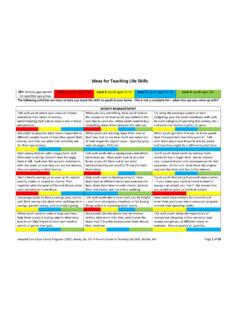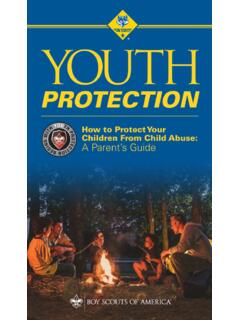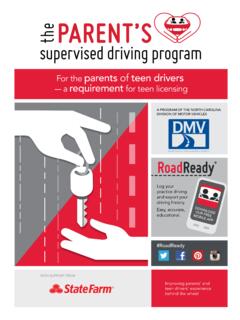Transcription of Guide to Teaching and Learning about Loss ... - Winston's …
1 Guide to Teaching and Learning about loss and bereavement in PSHE. lessons 1 Introduction On average, 1 in every 29 children will be bereaved of a parent. That's the equivalent of one in every For many people in the UK, talking about death is still a taboo which means that it is not something that is often talked about in families and in communities. However, it is something that impacts us all and it is important to provide the opportunity to learn about bereavement in PSHE and to support children and young people to develop the skills and understanding they need now and in the future to deal with this particular life event. As PSHE teachers we are used to Teaching about topics that many would consider sensitive and challenging. Please read this Guide prior to delivering these lessons in order to be as prepared as possible to teach these lessons and ensure a safe Learning environment for all.
2 2 about the lessons Development of lessons These lessons have been written by PSHE teachers working in Brighton & Hove schools and in partnership with Brighton & Hove's PSHE Service along with practitioners from the childhood bereavement charity Winston's Wish. Feedback has been sought from other teachers and this has informed the development of the lessons. The piloting phase was not possible because of the closing of schools over the summer term 2020. We ask schools to evaluate these lessons both with teachers delivering them and with pupils (Section and Appendices B and C) and would appreciate feedback so that we can continue to develop these resources. Both forms are available on line and paper forms can be returned by post. See Section for more details. Lesson content In this resources package you will find two lessons each for Key Stages, 1, 2, 3 and 4.
3 We have kept the number of lessons limited as we are aware of how much there is to cover in the PSHE. curriculum. The focus of these lessons is on grief and loss in relation to bereavement . Schools will want to ensure their PSHE curriculum covers a range of other losses including as a result of separation and divorce and change and transition such as moving class, school or home. The lessons cover statutory content and the PSHE Association Learning objectives outlined below: Key Statutory PSHE content PSHE Association Learning outcomes Stage covered Programme of Study references 1 that there is a normal range H11 I can recognise and name of emotions ( H12 some feelings happiness, sadness, anger, H14 I can describe how others fear, surprise, nervousness) H15 might feel and scale of emotions that H18. 1 | 1. all humans experience in H19 I can explain what is meant by relation to different H20 alive and dead experiences and situation I can tell you who I would ask show to recognise and talk for help if I needed it about their emotions, I can identify some ways to including having a varied manage feelings of loss vocabulary of words to use I can tell you who can help me when talking about their with difficult feelings.
4 Own and others' feelings 2 where and how to seek H14 I can recognise and name support (including H17 feelings associated with recognising the triggers for H18 sadness and loss seeking support), including H19 I can explain what is meant by whom in school they should H20 the word loss and grief speak to if they are worried H23 I can respectfully discuss about their own or someone difficult issues else's mental wellbeing or I can identify who I can ask for ability to control their support with difficult feelings emotions (including issues I can describe what I would do arising online) to support a friend who felt sad I can identify three ways of coping with loss or grief 3 that mental wellbeing is a H6 I can explain one thing about normal part of daily life, in H12 the nature of grief the same way as physical R21 I can identity a variety of health R22 emotions someone might experience when someone that there is a normal range important dies.
5 Of emotions ( I can explain where someone happiness, sadness, anger, can go to get help after a fear, surprise, nervousness) bereavement . and scale of emotions that I can describe a number of all humans experience in strategies that might help relation to different someone manage grief and experiences and situations loss I can support someone to get how to recognise and talk help. about their emotions, 4 including having a varied H5. I am able to discuss and vocabulary of words to use H6. define grief and bereavement when talking about their H10. I can describe the impact a own and others' feelings R11. death may have on a young R13. person where and how to seek I can reflect on people and support things that I can be grateful for I can describe a number of strategies that might help someone manage grief and loss I can suggest where to get help.
6 2. Cross-curricular links Death will be a topic that comes up in a range of subjects including books studied in literacy and English, in the exploration of historical events, exploration of issues such as poverty, and in response to current affairs and world events. Specific Learning about death in PSHE, science and RE below will strengthen ability of pupils and students to develop their own understandings and responses. Schools may wish to consider explicit linking so that KS2 Year 5 pupils will explore this topic in Science, RE and PSHE. Science study/national-curriculum-in-england-sci ence-programmes-of-study National Curriculum Science Year 2 Programme of Study: Pupils should be taught to: explore and compare the differences between things that are living, dead, and things that have never been alive National Curriculum Science Year 5 Programme of Study: Pupils should be taught to: describe the differences in the life cycles of a mammal, an amphibian, an insect and a bird Religious Education (RE).
7 Schools will follow the Standing Advisory Council for Religious Education (SACRE) Agreed Syllabus for RE for their areas. It is likely that this curriculum at Key Stages 2 and 3 will include references to death, the afterlife and rites of passage including funerals. This would effectively support these lessons as showing diversity of experience on the death of a loved one. In addition, death will come up in books read in literacy and English. Teaching and Learning methodology and resources These lesson plans follow best practice for PSHE guidance and include use of needs assessment, ground rules, active Teaching and Learning , assessment and calming activities. The Key Stages 1 and 2 lesson plans use texts (picture books) as the foundation of the Learning as we think this is the best way to approach these sensitive discussions.
8 These lessons are loosely based on a Philosophy for Children approach and so encourage the gentle development of discussion and opinion giving skills whilst building pupil skills in managing difficult feelings. The Key Stages 3 and 4 lesson plans use a range of stimulus material to prompt discussion and exploration. Some picture book resources may need to be purchased to deliver these lessons. These, along with other resources would also be useful to have in the library for pupils to read or to share with families who may be supported by them (see Reading List below). However, many of the primary books used in these lessons can be found read online if buying resources is a challenge. 3. Representation of equality and diversity Some diversity is shown on the PowerPoints and in some of the resources. Winston's Wish is currently working to improve the diversity shown in its website videos and will reflect this in these resources over time.
9 We would welcome any suggestions from teachers who have identified other story books and other resources about bereavement that better represent diverse families. Schools can ensure that all staff have understanding of the different approaches to death in the faiths represented in school. RE Teaching about rites of passage as described above could be supportive to these lessons. One place to start could be rituals-in-world-religions/. Preparing for delivery These lessons will need to be embedded in your school Programme of Study for PSHE. To do this: Identify the year group where the lessons fit best (considering any cross-curricular links). Review and make any changes to the lessons to support pupils or students in your setting and source necessary resources Identify the part of the PSHE curriculum where the lessons can be slotted in: this is likely to be in parts of the curriculum about managing difficult feelings or mental health and wellbeing Add reference to these lessons to the curriculum overview shared on the school website.
10 Teacher training and ongoing support Teacher training is recommended prior to the delivery of these lessons to ensure a safe and effective Learning environment for all. Some of the following suggestions for training may be beneficial. 1. Training to build understanding of how bereavement can impact on children and young people. This can be accessed via the following providers: Winston's Wish offer free online training modules for primary and secondary teachers or face to face/video training days: you/professionals-and-training/. Educare in partnership with Winston's Wish: Creative Education students-with- bereavement /. 2. Training in how to deliver bereavement lessons as part of PSHE education: content/courses/pshe_ #/id/5ef07c876a21c6074e18e645. 3. You may also wish to view the following video which sets out some of the theory behind supporting grieving children: In addition, support can be provided by the Winston's Wish Freephone National Helpline.







